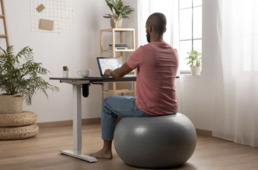
Stretching is often overlooked or treated like the side salad of a workout, it’s nice in theory, but easy to skip. In reality, mobility stretches are one of the most valuable things you can do for your body and longevity. They don’t just keep your muscles loose; they keep your joints healthy, your movements smooth, help prevent pain and injuries, and keep your body ready for whatever life throws at it.
Mobility stretches target specific joints and muscle groups to improve flexibility, strength, and coordination. When practiced regularly, they can prevent injuries, enhance performance, and help you maintain joint health as you age. Whether you’re a runner, a weightlifter, or someone who sits at a desk all day, improving mobility means moving with less stiffness, less pain, and more control.
- Hip Circles: Loosen tight hips and improve lower-body movement.
- Cat-Cow Stretch: Open up your spine and ease tension from sitting.
- Arm Circles: Warm up your shoulders and improve range of motion.
- Ankle Rolls: Strengthen and stabilize your ankles to prevent sprains.
- Thoracic Twists: Improve spinal rotation and release upper back tightness.
What Are Mobility Stretches? Are They Just Regular Stretches?
Mobility stretches are dynamic movements that take your joints through their full range of motion. Unlike static stretches, which involve holding one position, mobility work involves gentle, controlled movement. Think of them as if you are oiling your joints, it helps to keep them moving smooth, lubricated, and responsive. These movements increase blood flow, warm up the muscles, and prime your body for both workouts and daily activity.
Why Is Mobility Important?
Mobility is what lets you live life comfortably. You need mobility to bend to tie your shoes, to reach for the top shelf, and when you twist to grab something from the back seat. When your mobility is limited, everything feels harder and stiffer and sometimes causes pain. Over time, a lack of movement can lead to muscle imbalances, extreme pain, and even injury. Regular mobility training keeps your joints functioning properly, improves circulation, and supports better posture and balance.
Mobility vs. Flexibility: There is a Difference
Flexibility is about how far a muscle can stretch. Mobility is about how well that stretch translates into movement. You could be flexible enough to touch your toes but still have poor mobility if your hips or spine aren’t working together properly. Mobility training combines strength, balance, and flexibility allowing your body to move with power and stability, not just reach a certain position.
Good mobility means your joints, muscles, and nervous system are all communicating efficiently, creating smooth, controlled motion instead of stiffness or strain. Without good mobility, even simple tasks can feel awkward or restricted. By focusing on mobility training, you’re not just increasing range of motion, you’re improving coordination, posture, and overall movement quality, setting a strong foundation for both fitness and daily life.
Benefits Can Be Almost Immediate
Mobility work produces results faster than most people expect. After just a few sessions, you’ll likely notice less stiffness, smoother movement, and better posture. Even after your first session you may just feel lighter and looser all over.
Over time, with continued mobility work, you may also find that you recover more quickly after workouts and experience fewer aches in common problem areas like your lower back, shoulders, and hips. Improved mobility also helps your nervous system because it teaches your body to move more efficiently, which can boost both performance and coordination.
Easy Mobility Stretches to Get You Started
You don’t need special equipment or a gym to start improving mobility. A few minutes a day is enough. Try these easy options:
Even five to ten minutes before or after a workout can make a noticeable difference.
Mobility for Sedentary Workers
If your day involves long stretches of sitting, mobility exercises are non-negotiable. Hours in front of a screen can cause tight hips, rounded shoulders, a stiff neck, and many other issues. Simple moves like shoulder rolls, neck rotations, or hip openers between meetings can reset your body, loosen your joints and boost focus. You’ll feel more energized, less achy, and probably get fewer tension headaches too.
How Aging Affects Mobility
Mobility becomes even more important with age. As we age, joints lose elasticity and cartilage thins. Regular stretching helps keep movement fluid and pain-free. It also strengthens stabilizing muscles, which lowers the risk of falls and injuries. Mobility work supports independence and confidence, allowing you to keep doing the things you love for longer.
Beyond the physical benefits, maintaining mobility as you age has a profound effect on your quality of life. It allows you to move comfortably, stay active in hobbies, and maintain a sense of freedom that’s easy to take for granted when you’re younger. Regular mobility exercises also promote better balance, coordination, and circulation, which all contribute to feeling more energetic and capable. In short, mobility training isn’t just about moving well, it’s about living well, keeping your body resilient and your spirit strong as the years go by.
The Mind-Body Bonus
Mobility stretching can also double as a mindfulness practice. Moving slowly and deliberately helps calm the nervous system and releases mental tension. It’s a few minutes to breathe deeply, tune in to your body, and shake off stress. It’s basically meditation in motion.
When you focus on how your body feels during each stretch, how your muscles lengthen, how your joints open, you build awareness and connection with yourself. That presence carries into other parts of your day, helping you stay grounded and centered even when life feels hectic. The rhythmic flow of movement and breath can also lower stress hormones, improve mood, and boost mental clarity. Over time, mobility training becomes more than just physical—it turns into a ritual of self-care that strengthens both body and mind.
FAQ: Mobility Stretching Made Simple
1. How often should I do mobility stretches?
Daily is ideal, but even three to four sessions a week can make a big difference. Consistency matters more than intensity.
2. When’s the best time to stretch?
Mobility stretches are great as a warm-up before workouts or as a cool-down afterward. You can also sneak them into your morning routine or work breaks. The most important thing is that you do them, rather than when.
3. How long should a mobility session take?
Five to fifteen minutes is plenty. Short, regular sessions beat long, infrequent ones every time.
4. Can mobility work replace stretching or strength training?
Not exactly. It complements both. Mobility blends flexibility and control, helping you get more out of strength and endurance training and is helpful for recovery.
5. Do I need to be fit to start?
Absolutely not! Mobility work is for everyone, and everyone should be doing it. From beginners to athletes, all bodies will benefit from mobility work. You can modify movements to match your comfort level and progress gradually.

Mobility stretching is one of the simplest ways to keep your body strong, balanced, and pain-free for longer. Whether you’re looking to improve performance, ease stiffness from sitting, or age with more grace, independence and less discomfort, these stretches are worth your time. Just a few mindful minutes a day can transform how you move and how you feel in your own body.
Related posts




